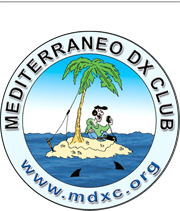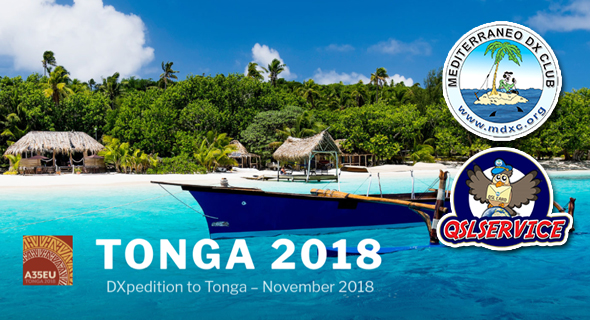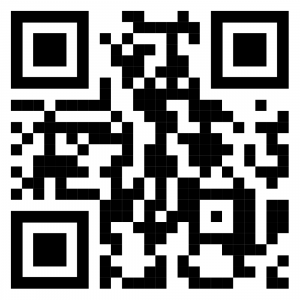The kingdom of Tonga 2018 A35EU by Ronald PA3EWP
How did this adventure start? During a few beers during the Hamfest in Friedrichshafen we were talking about our next destination. We mentioned a few destinations in the Pacific. Personally, I don’t like to go twice to the same country. A few destinations were out of our scope because of the cost and the difficulty to go to this DXCC country. Frank DL4KQ mentioned Myanmar and everybody thought that was a great idea. From July to half September we have been working on this destination, Frank did most of the work because he had some contacts in Myanmar. He also flew to Myanmar for some arrangements with the local government. Everything seems fine, but after 1 month back home, we still didn’t receive the official papers. We wanted to go to Myanmar in October, so only a few weeks left to organize this trip. We started to look for a backup plan. At the Hamfest we talked about Tonga as one of the destinations. This is an easy place to activate, a lot of tourists go there, daily flights and a license is also no problem. Tonga is not so high on the most wanted list, but for Europe still interesting. Within 2 weeks nearly everything (license, location, flights) was organized. So, we were ready for the following step. End September we decided to postpone Myanmar and focus on Tonga. Only 3 operators Tom GM4FDM, Martin PA4WM and Ronald PA3EWP wanted to go to Tonga. We needed a fourth operator, soon this place was filled by Pat EI5IX. The team was ready to go for a new adventure.
The Kingdom of Tonga Tonga, is a Polynesian country and archipelago comprising 169 islands, of which 36 are inhabited.
The total surface area is about 750 square kilometers (290 sq. miles) scattered over 700,000 square kilometers of the southern Pacific Ocean. The sovereign state has a population of approx. 100,000 people of whom 70% reside on the main island of Tongatapu.
The Tongan people first encountered Europeans in 1616 when the Dutch vessel Eendracht, captained by Willem Schouten, made a short visit to trade. Later came other Dutch explorers, including Jacob Le Maire (who called on the northern island of Niuatoputapu); and in 1643 Abel Tasman (who visited Tongatapu and Haʻapai). Later noteworthy European visitors included James Cook (Royal Navy) in 1773, 1774, and 1777. Tonga became independent in 1970 but is still a part of the commonwealth of nations.
Location on the Island We found a nice location on the western part of the main Island. A previous Scottish DXpedition used this QTH also, they gave us a lot of useful information. It was possible to setup the antennas the border of the beach. On the beach itself was impossible because it was used also by other visitors. The beach resort Heilala at Kanokupolu is located at the Ha’atafu beach. Because of the low season we got card blanche to setup our antennas, we had only to take care of not disturbing the few other guests.
Big challenge Our biggest challenge would be the low sunspots. Nearly at the bottom of this sunspot cycle it would be a challenge working Europe. Looking at the propagation prediction programs it would be possible to work western Europe only on 20, 30 and 40 meter. But with weak signals. So, the challenge became bigger. We new that every additional dB of gain would be very helpful. We decided to make VDA’s for 17, 20 and 30 meter. Martin with help from Jan PA4JJ and Henk PA3GCV build the VDA’s and the other wire antennas. They did a great job!
Travel to the Kingdom Tonga It would be a long journey to travel to our destination. The team meeting-point would be Doha in Qatar. Tom flew from Edinburgh, Pat from London and Martin and I from Amsterdam. We left Tuesday 23 November for a 6-hour flight to Doha. Pat joined us a one hour after we arrived. We received a message that Tom had a challenge. His plain was broken and could not leave Scotland. This would be a challenge to catch his connection flights. When we boarded our plane to Auckland, we received a message that his delay was 5 hours and maybe we would meet him in Auckland. For the next 17 hours it would be quiet without any info from Tom. This is the second longest flight at this moment, and we can say that is long! We arrived in Auckland and heard that Tom would leave Doha in a few hours, so he would arrive only 1 day later at Tonga.
We had still 11 hours transit time in Auckland before our next flight. We put all our luggage in a storage room and went by taxi to Auckland city, had a nice short walk and a visit at the sky-tower to overview Auckland from 220m height. After a lunch we went back to the airport for our last part of the trip to Tonga. This flight was only 2 1/2 hours. We arrived Tonga airport around 19.30 local time. After collecting our luggage and a nearly 1-hour drive, we arrived at 21.30 at the resort Heilala.
Antenna setup Early next morning, after breakfast we started assembling our antennas. We would focus on 17, 20, 30 and 40 meters for the first day. We soon noticed that we would have a challenge with the coaxcables. We brought approximately 500 meter of coax-cable with us. From the shack to the beach was circa 100 meters. Around noon I had to quit for meeting Tom at the airport. He arrived around 13.00. From the airport we went to the Telecommunication office to collect our license. We already had a few times contact with Officer of Telecommunication by email and phone about the license. He had added the possibility to operate 60m band, we were very pleased with this extension. For many or maybe everyone it would be a new DXCC on 60m. After leaving the office we went shopping and back to the resort. Martin and Pat were ready with the 17 and 20-meter VDA, the 30m VDA had only to be erected. We needed 4 men to finish this job. The 40-meter vertical was also ready to use.
The next day we would finish the other antennas, 10/12/15m multiband vertical, 80 meter vertical. For RX we used a DHDL antenna. We were waiting for a local guy which would climb into a 17m high palm tree to make a rope on top of it for the 160m vertical. After 2 days we decided not to wait longer and started to throw a rope over a palm tree and do the job our self. We chose a palm tree approx. 12-meter-high for 160m and another palm tree for 60 meters. A few hours later both antennas were ready for use. The antenna farm was completed. Luckily there were not many other guests, so we could use all the space we needed for our antennas.
Equipment: We had 3 complete stations operational, one radio was for spare. Some hours of the day we operated 3 stations simultaneously.
Radio setup: Radio Amplifier Elecraft K3 Expert 1.3 Elecraft K3 THP 1.1 SUNSDR Homemade 600 watt
Antennas: Band Antenna 160m Inverted Vee 80m Vertical + 1 elevated radial on 18m Spiderbeam pole 60m Inverted Vee 40m Vertical + 1 elevated radial on 11 meter fiber pole 30m VDA on 18m Spiderbeam pole 20m VDA on 12 meter fiber pole 17m VDA on 12 meter fiber pole 10-15m Multiband vertical + 1 elevated radial per band on 11 meter fiber pole
We were using bandpass filters between radio and amplifier. Logging was done with WIN-test and WSJT-X. The computers were wireless networked. We used the Microkeyer MK2 as interface between radio and computer. There was a good internet connection, so we uploaded on daily basis our log to clublog.
Operating and propagation All operators are mixed mode operators, everyone had his preferred mode. We focused on the main modes CW, SSB and RTTY. Due bad propagation most of the QSO’s were in CW. We switched a lot from mode. We noticed that due bad propagation we were forced to use FT8. There was a high demand for this mode. Searching the bands, no activity on the band only on the FT8 frequencies (we hope this will change quickly).
During the morning hours there was not much propagation at all, so we did some site seeing and other necessary things like shopping. In the morning we used mainly 17 and 20 meters. Around noon, 15 meter was sometimes open for a few hours, mainly to Japan and some North-America. 12 meter was only open to Japan.
For Europe 17 and 20 meter were the best bands. By the way 20 meter was the best band for all continents. 30, 40 and 80 meter were also good bands, but also difficult for western Europe. On day 3 we moved the 40 meter vertical more to the beach. The noise on 40m was high. After we moved it, the noise was reduced at least with 6 dB. We had no coax-cable left, so we had to combine 17m and 40m. It seems that everything direction 350 – 10 degrees (western Europe) was extremely difficult. That is the reason why there are only a few F, DL, ON, PA, G and GM are in the log. The propagation stopped around Poland, it didn’t move further to the west.
On 60 meter we had a tremendous S9+ QRM, it was some QRM generated in our resort. We replaced the polarization of the antenna from vertical to horizontal, but that didn’t help. The day after we hang the dipole 50 meters further away from the buildings, the QRM was still the same. We could make much more QSO’s in the log without this QRM. FT8 was doing a good job getting the weak signals out of the QRM.
The last morning the QRM was at the minimum and we logged many Western Europeans on 60 meters.
Our DHDL receiving antenna was not performing well, we tried it the first day, but without success on all the low-bands.
Propagation on 160m was terrible. We were forced to use an inverted vee instead of an inverted L. The noise on this band was S9, very difficult to copy anything. On the DHDL antenna the signals were not readable at all. I tried also listening on the 80m vertical, but the noise was also very high. So, we were forced to use FT8 also on this band. We didn’t make many QSO’s on 160m. We spent our effort on the other bands due the high noise on the magic band.
In total we make a little bit more than 17.098 QSO’s which off 7.240 unique calls. We expected a little bit more, but the circumstances did not allow much more.
During our last weekend on Tonga we participate in the CQ WW CW Contest. Participating in a contest from the Pacific is completely different than contesting from Europe. It was a nice experience, we learned a lot of it. We made in total 1.700 QSO’s in the contest. Without the contest we would have made more QSO’s in the same time. It is difficult to find a clear frequency and after that to keep your frequency. A lot of times we were covered by the NA and EU mesh.
Last day We had to pay a lot of overweight coming to Tonga. We didn’t want to pay it again on the way back. The price of the overweight was more that the new value of the mast and coax-cable. We decided to find another way to send the fiber mast and coax back home, the alternative was leaving it on Tonga and buy new ones at home. But why not sending it to Tarawa for my next DXpedition to Kanton T31EU? After a few telephone calls we made the decision to send it to Tarawa, that was much cheaper than sending it back home and take it with us to Kanton in February. The last morning we packed the ski-bag (35 KG) and brought it to Fiji airways for transport via Fiji to Tarawa. Chuck our contact person on Tarawa would take care of the final handling of the ski-bag.
We had another quick visit in town before we went back by bus to the resort. The last stuff was packed and at the end of the afternoon we were ready to leave for the airport. After 2 ½ hour flight we arrived at Auckland airport. We went to a hotel for a few hours sleep. At 09:00 o’clock in the morning we went by taxi to the city center for a breakfast. After breakfast we walked around a little bit and went back to the airport. The flight from Auckland to Doha was 17½ hours. It was a very bumpy flight. Arriving at Doha airport we had another 8 hours transfer till our departure back home. We went to a lounge to relax, we had a nice shower and breakfast. After a few hours the team separated, Pat went back to London, Tom to Edinburg, Martin and I to Amsterdam. 6 hours later we were back in the Netherlands after travelling for two days.
QSL Tom, GM4FDM is our QSL manager, all QSL will be answered by Buro, OQRS and Direct. A short time after our DXpedition the logs will be uploaded to LOTW.
Many thanks for the support from de DX-clubs: OHDXF Finland, SDXF Swiss DX Foundation, EUDXF European DX foundation, LYNX DX Group, Clipperton DX Club, BARTG, LADXG – LA DX Group Norway, FEDXP Far East DX Ploiters, EIDX group, GPDX Portuguese DX group , CDXC The UX DX foundation, ETDXA The East Tennessee DX Association, Lone Start DX Association, Mediterraneo DX Club, GDXF German DX Foundation, GMDX group and RSGB. And the many individual sponsors, especially Alex PA1AW for his support and maintaining the web-site.
For more information and photo’s see our website: http://tonga.lldxt.eu and Clublog for more statistics.



 TO7PX Reunion
TO7PX Reunion VK9LA Lord Howe Isl.
VK9LA Lord Howe Isl.

